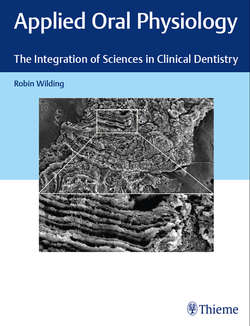Читать книгу Applied Oral Physiology - Robin Wilding - Страница 68
На сайте Литреса книга снята с продажи.
4.2.4 Gingival Crevicular Fluid
ОглавлениеFilter paper inserted into the gingival sulcus soon becomes saturated with crevicular fluid. This fluid derives from the connective tissue of the gingiva, passes through spaces in the junctional epithelium, and enters the gingival sulcus. The rate of flow and composition of the gingival crevicular fluid (GCF) are influenced by the following factors:
• The fluid flow is minimal in the morning and reaches a maximum at the end of the day.
• GCF flow is increased by tooth brushing and mastication.
• Pregnancy causes the rate of GCF to increase. There is an increase in gingival inflammation represented by a tendency for gingival bleeding during pregnancy.
• Fluid flow is minimal during the middle of the menstrual period.
• GCF flow is increased in diabetics.
• One of the earliest signs of gingival inflammation is an increase in GCF flow. There is some correlation between the rate of flow and the severity of the gingival inflammation.
The spaces between the cells of the junctional epithelium comprise 18% of its volume. These spaces are large enough to allow the passage of large molecules and cells (see Chapter 3.7 Junctional Epithelium). Thus, bacteria and their toxic products and other antigens may enter the gingival connective tissue through the junctional epithelium. This constant minor invasion causes a mild inflammatory state in the lamina propria of the junctional epithelium. Hence, neutrophils which have migrated into the junctional epithelium in response to the presence of bacterial products are flushed out into the GCF fluid. From this route, 25,000 neutrophils enter the mouth every 15 minutes. Other cells found in the GCF are desquamated epithelial cells.
In health, the GCF is neither exactly like serum or an inflammatory exudate. There are slightly higher concentrations of inorganic ions than in serum and higher levels of carbohydrates. The serum immunoglobulins, IgG, IgM, and IgA, are all found in GCF (not the secretory version of IgA which is found in saliva). Their presence may regulate the entrance of bacteria into the epithelium. One of the functions of antibodies is in triggering the complement cascade of reactions which produce enzymes capable of inflicting damage to the cell walls of bacteria. These enzymes are also capable of damaging host cells, and this may be another reason for the inflammatory state of the lamina propria under the junctional epithelium. The enzymes found in GCF are evidence of the battle between invading bacteria and the defending neutrophils. For example, there is acid phosphatase (from cell breakdown), glucuronidase, lysozyme, hyaluronidase, and collagenases.
